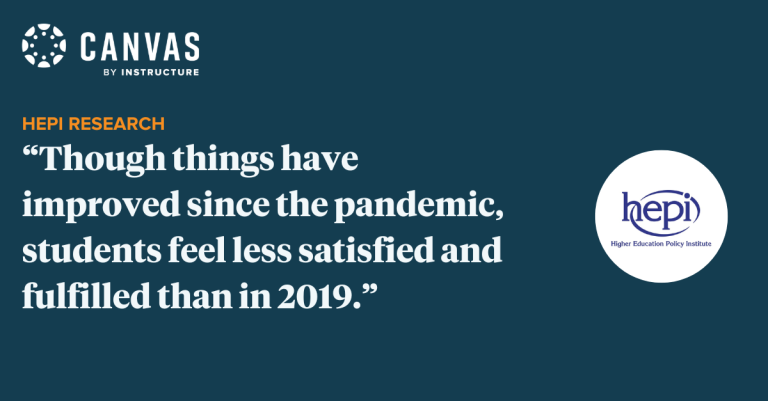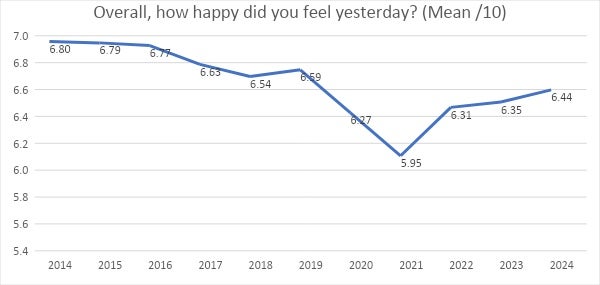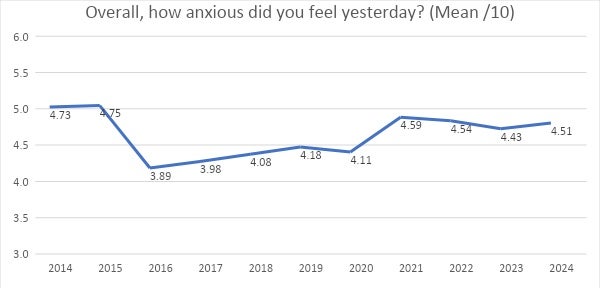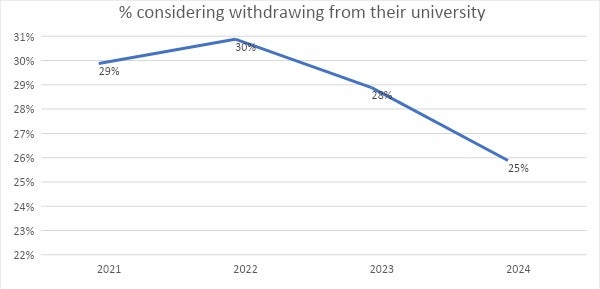
As the nation continues to digest the findings of the first Covid inquiry report published on 18 July 2024, we might take this opportunity to consider the ongoing impact of the pandemic on higher education.
The 2020/21 pandemic was a global health crisis and was hugely destabilising for the UK, the higher education sector included. At short notice, classes and exams had to be moved online. Lockdowns meant students needed to isolate in a household with people they might have barely known and at a formative period in their lives. Students were among many groups in society whose wellbeing suffered as a result of these challenges, and the effect on students’ mental health has been well-documented by HEPI and others. At the time, many said the pandemic would have ripple effects for years or even decades to come.So to what extent have those ripple effects come to pass?
Trends in student wellbeing
Every year, HEPI and Advance HE publish the Student Academic Experience Survey (SAES), a huge study of over 10,000 current undergraduate students. We have been asking the same questions for many years, and some of our data on student wellbeing goes back to the 2013/14 academic year.
This allows us to identify some important trends in student wellbeing before, during and after the pandemic. It is important to note that the fieldwork for the 2019/20 survey was conducted between 17 February and 4 April 2020, and the first lockdown was announced on 23 March. In other words, respondents were either unaware of the crisis or just beginning to witness the events unfold.

Unsurprisingly, these data show that student wellbeing took a big hit around 2020. Self-reported happiness had been gradually declining in previous years. Wellbeing then decreased sharply in 2020 and again in 2021 to its lowest level on record. The survey records a significant improvement in 2022 after restrictions were lifted and the main threat of Covid had passed, and again in 2023 and 2024. But the scores remain a little lower than was recorded in 2019.
We also dug deeper and asked students how worthwhile they find activities and how satisfying they find life. Though things have improved since the pandemic, students feel less satisfied and fulfilled than in 2019.

Self-reported anxiety levels appear to be of greater concern. Perhaps surprisingly, students reported lower levels of anxiety in 2020 as compared with 2019. This may reflect the timing of the survey, as the first lockdown restrictions were only introduced after most data had been collected. But anxiety levels shot up in 2021 and, unlike other metrics, have not recently improved. Instead, students reported feeling about as anxious in 2024 as they did in 2021.
Risk of withdrawal
Other data from the SAES can help to explain these trends. Since 2021, we have asked students whether they have considered withdrawing from their institution. Though we don’t have earlier data to compare these results with, they do tell us how much things have improved since 2021, right in the middle of the pandemic.

These findings show some improvement, with only around a quarter (25%) considering withdrawing in 2024 compared with around three-in-10 (29%) in 2021. But readers should also note that anyone who did drop out is not in the data, so we only have half the story.

Every year, the top reason for withdrawing from university, and by a huge margin, has been students’ mental health. But this has been partly displaced by financial concerns, likely connected to the cost-of-living crisis.
When asked why they might withdraw from university, students were more likely to say this was because of family or personal problems than in 2021. They are less likely now to attribute this to course delivery compared to 2021. Institutions took time to adapt to a new kind of learning, and many classes shifted online, allowing the benefits of edtech solutions like Canvas LMS to be fully realised.
Data on the proportion of classes held online indicate there has been a shift towards a blended approach to learning, with a return to in-person classes held in tandem with remote classes, allowing greater flexibility for the student., though a significant proportion are still held remotely.
The 2024 SAES also showed an uptick in most other measures of teaching quality, so wellbeing challenges do not appear to be a result of lingering changes to teaching practices or processes. Instead, students may be feeling the effects of a very difficult period several years on, with the situation made worse by financial challenges.
Some more evidence in favour of this finding comes from Unite Students, which conducts annual research into the wellbeing and preparedness of applicants to higher education. In 2021, Unite Students reported that those applying to university are less confident than previous cohorts, more socially anxious and less enthusiastic about social events. Even in 2024, students’ anxiety levels remain higher than in 2019 and students report more issues with their mental health, such as eating disorders.
The above makes for difficult reading. It appears that the pandemic has had a long-lasting effect on students’ mental wellbeing, particularly around anxiety, social interaction and mental health. But there are silver linings as well, particularly that students feel almost as happy and satisfied with their lives as they did in 2019.
So how can we better support students?
The following recommendations, each of which has been argued in HEPI reports and blogs, might be a good starting point:
- Institutions should consider asking key welfare questions during the registration process, including about caring responsibilities, commuting time and hours of paid work. They can then consider the necessary adjustments to support students fully.
- Institutions should embed student wellbeing into the curriculum, so it is accessible to everyone, not just those who opt into it. They can also make use of their online platforms to promote the available wellbeing resources.
- They should make careful use of data to understand students better and target support where it is needed most.
- And they should streamline their hardship funding processes, to better help students access emergency funds when they need it.
The pandemic has caused huge disruption to students’ journeys through education, but by modifying our approach, we can help every student to feel happy and confident during their time in higher education.
Related Content
 canvas_he_-_webinar_2.png
canvas_he_-_webinar_2.pngBlogs
 canvas_he_-_webinar_1.jpg
canvas_he_-_webinar_1.jpgBlogs
 canvas_he_-_webinar_1.png
canvas_he_-_webinar_1.pngBlogs
